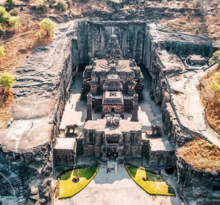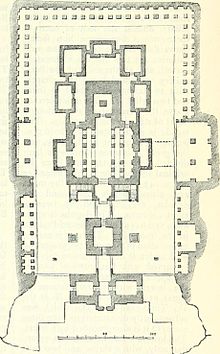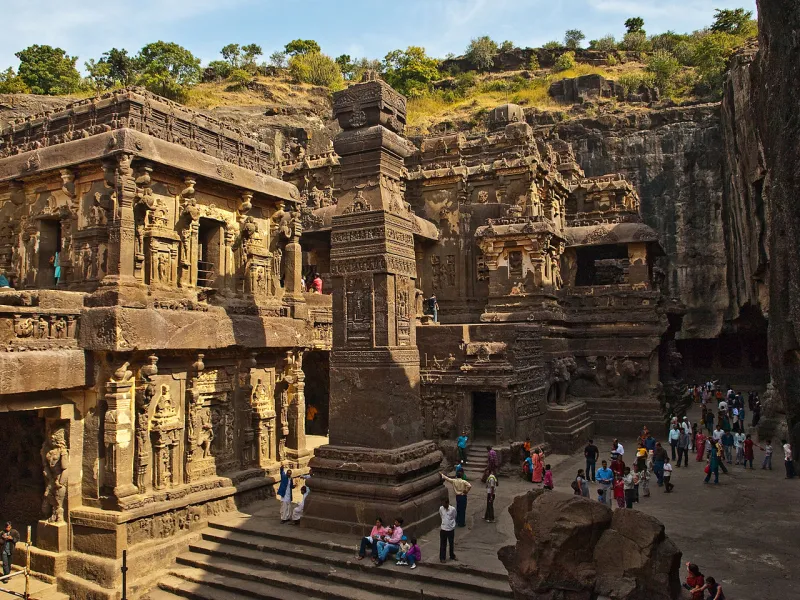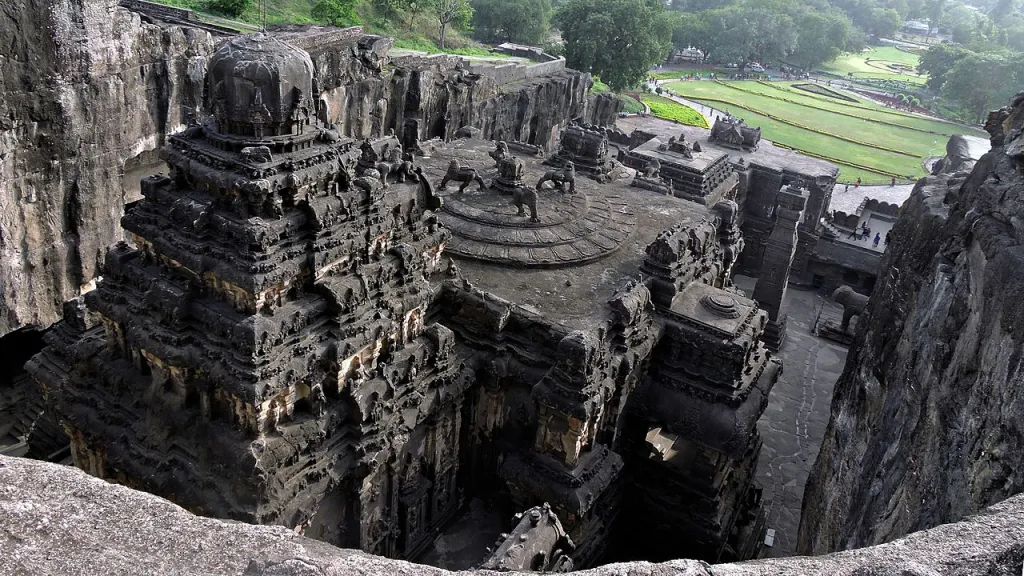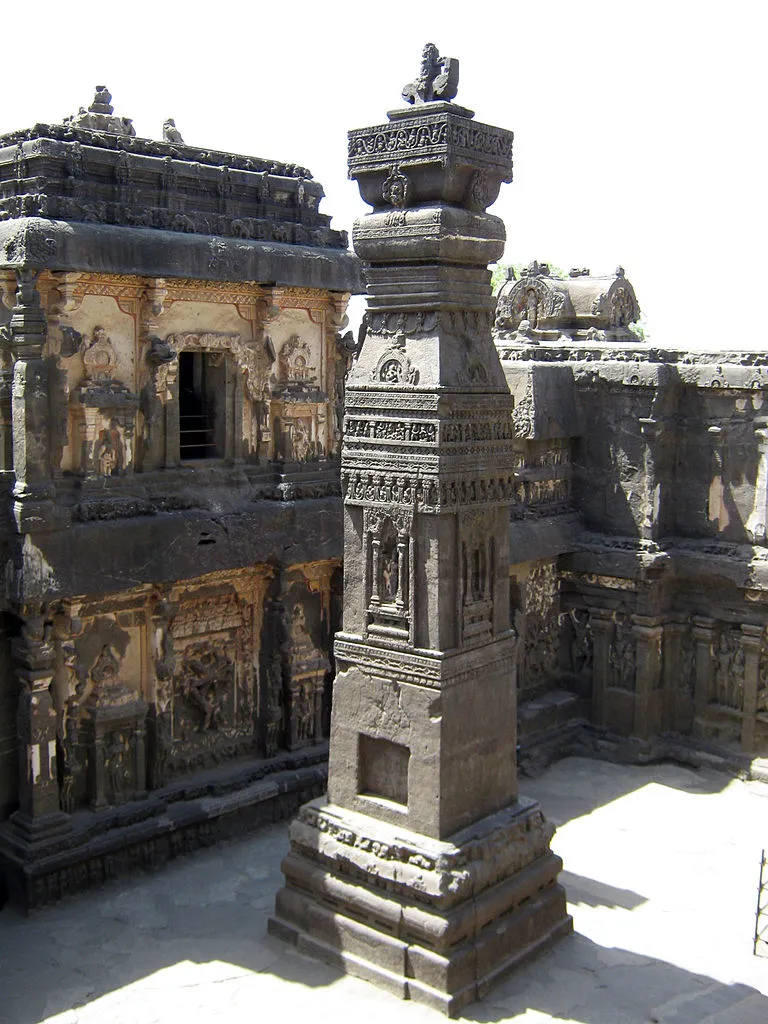Editor’s Note – The Taj Mahaal is described as a Wonder of the World. It is beautiful and possibly a small wonder. But we confess we were left unimpressed even while watching it on Kojagiri night, a gorgeous full moon night. Several years later, we saw the Ajanta Caves, a complex of 15+ caves of beautiful Buddhists carvings & paintings. We were impressed but not mega-impressed because we could imagine how they were constructed. Then we saw the Kailaash-Nath Temple in the Verul complex adjacent to the Ajanta complex. We were absolutely astounded & stumped. Not only was the scale, the architecture & the carvings were beyond our ken, the entire temple structure utterly confounded us as it does architects around the world. It is absolutely unfathomable to us.
We have thought of India as the America of the first CE millenium. This is neither random nor vain. First & foremost, the GDP of India in 900 CE was 38%-39% of global GDP and America’s GDP at its zenith after World War II was also 38%-39% of Global GDP.
In terms of technology & science, Indians were far ahead of Europeans then just as Americans are ahead in technology & science today.. As old Sanskrut texts get read, translated & analyzed, it seems clear that a steady stream of Indian Mathematicians, Physicians, Astronomers had studied & developed complex technologies by 1000 CE which Copernicus, Galileo & Fibonacci followed in the 1200-1400 renaissance period.
Today, we point to an unfathomable achievement in architecture, construction & technology the likes of which are not seen in today’s world (except a few such as Pyramids). And this achievement seems impossible to recreate even today despite the enormous advances in every science & technology. It is so unfathomable that “learned” estimates of leading architectural experts are now ridiculed by any one who simply can think.
We are speaking about the magnificently improbable structure called the Kailaash-Naath Temple (Kailaash Temple, for short). The Scientific Inquirer described it in their October 28, 2021 post as:
- “The Kailash temple is believed to be the largest monolithic structure in the world. Hewn from volcanic granite and nestled among the rocks 30 km away from DevGiri*, Maharastra, it is an incredible work of architecture that rivals the present wonders of the world. Carved out of a single rock, the temple is huge (200 ft X 100 ft X 90ft height) as well as stunning. “
- “What inspires a sense of bewilderment and wonder at the magnificence of the imposing structure is that the temple was built top-down.”
Built top-down from a single huge rock by cutting out of the portions of the rock that were not needed. That leads to a big mystery. To build this imposing structure, “the granite estimated to be excavated for the temple complex ranges from 200,000 – 500,000 tons“.
How is that possible given the historian belief that this Temple was built in 18 years. As the most basic of calculations show, this would have meant cutting & excavating 4-5 tons of rock every hour followed by the complex carvings followed across the mammoth temple. Architects believe that is NOT possible even today with all the sophisticated machines we have.
The second problem is the 200,000-500,000 tons cut & excavated rock would have been discarded somewhere. But as the article says ” … it is nowhere to be found for a 50 km radius“.
So either the construction of this temple took over 100 years as some now argue or the rock portions cut out & excavated were burnt & sucked out of the large crevice. But such power could only be developed via a Nuclear or a meteoric force. Yes, “about 170 km from” the temple, “is the 50000-year-old, Lonar Crater Lake, created by a meteoric impact“. But is that even relevant?
To understand the scale of the Kailaash Temple, first see the top-down photos from Wikipedia:
And this was not merely a temple. The Scientific Inquirer points out that besides the 600 statues, the Temple structure has,
- “intricately perforated windows panes, bridges from the temple to the imposing gopuram, rainwater harvesting, intricate drainage system, ventilation shafts that narrow to a size that discourages human entry, hidden underground passages, secret peepholes, balconies, and stairways which connect different levels of the temple structure.”
Below are some photos from the Scientific Inquirer article used with gratitude & respectful courtesy:
Look at the above & marvel. And, if you can spare 9 minutes, watch the clip below from Ancient Architects titled The Mystery of the Kailasa Temple of India
*We cannot use the imposed aurangabad name any more than we would use an Osama-name to a structure in Manhattan. So we used the pre-Osama-aurang & true Indian name Dev-Giri.
Send your feedback to editor.macroviewpoints@gmail.com Or @MacroViewpoints on Twitter
